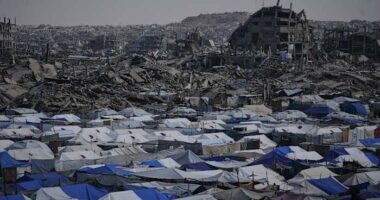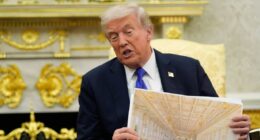Share this @internewscast.com

The threats, pressure, and ultimatums have surfaced and subsided, yet Russian President Vladimir Putin has steadfastly upheld Moscow’s unwavering demands in the Ukraine conflict, sparking concerns about potential coercion towards Kyiv during a prospective summit with U.S. President Donald Trump in Alaska.
The maximalist demands reflect Putin’s determination to reach the goals he set when he launched the full-scale invasion of Ukraine on Feb. 24, 2022.
Putin views a prospective meeting with Trump as an opportunity to negotiate a comprehensive agreement that would not only solidify Russia’s territorial advancements but also prevent Ukraine from joining NATO and hosting any Western military presence, thereby enabling Moscow to incrementally draw Ukraine back into its sphere of influence.
The Russian leader believes that the passage of time favors him, as the fatigued and outmatched Ukrainian troops grapple to counter Russian progress across the extensive over 1,000-kilometer front line, while waves of Russian missiles and drones ravage Ukrainian cities.
Ukrainian President Volodymyr Zelenskyy has similarly maintained a resolute stance, agreeing to a Trump-proposed ceasefire while reiterating the nation’s determination to pursue NATO membership and refusing to recognize Russia’s annexation of any of its regions.
A look at Russian and Ukrainian visions of a peace deal and how a Putin-Trump summit could evolve:
Russia’s position
In a memorandum delivered during June negotiations in Istanbul, Russia presented Ukraine with two options for initiating a 30-day ceasefire. One option called for Ukraine’s withdrawal from Donetsk, Luhansk, Zaporizhzhia, and Kherson — the four regions unlawfully annexed by Moscow in September 2022 but never entirely controlled.
Alternatively, Russia proposed a “package proposal” requiring Ukraine to suspend mobilization, halt the delivery of Western weaponry, and prohibit any foreign forces on its territory. Moscow also suggested that Ukraine lift martial law and conduct elections, following which the parties could finalize a comprehensive peace treaty.
Once there’s a truce, Moscow wants a deal to include the “international legal recognition” of its annexations of Ukraine’s Crimean Peninsula in 2014 and the four regions in 2022.
Russia says a peace treaty should have Ukraine declare its neutral status between Russia and the West, abandon its bid to join NATO, limit the size of its armed forces and recognize Russian as an official language on par with Ukrainian -– conditions reflecting Putin’s earliest goals.
It also demands Ukraine ban the “glorification and propaganda of Nazism and neo-Nazism” and dissolve nationalist groups. Since the war began, Putin has falsely alleged that neo-Nazi groups were shaping Ukrainian politics under Zelenskyy, who is Jewish. They were fiercely dismissed by Kyiv and its Western allies.
In Russia’s view, a comprehensive peace treaty should see both countries lift all sanctions and restrictions, abandon any claims to compensation for wartime damage, resume trade and communications, and reestablish diplomatic ties.
Asked Thursday whether Moscow has signaled any willingness to compromise to make a meeting with Trump possible, Putin’s foreign affairs adviser Yuri Ushakov responded that there haven’t been any shifts in the Russian position.
Ukraine’s position
The memorandum that Ukraine presented to Moscow in Istanbul emphasized the need for a full and unconditional 30-day ceasefire to set stage for peace negotiations.
It reaffirmed Ukraine’s consistent rejection of Russian demands for neutral status as an attack on its sovereignty, declaring it is free to choose its alliances and adding that its NATO membership will depend on consensus with the alliance.
It emphasized Kyiv’s rejection of any restrictions on the size and other parameters of its armed forces, as well as curbs on the presence of foreign troops on its soil.
Ukraine’s memorandum also opposed recognizing any Russian territorial gains, while describing the current line of contact as a starting point in negotiations.
The document noted the need for international security guarantees to ensure the implementation of peace agreements and prevent further aggression.
Kyiv’s peace proposal also demanded the return of all deported and illegally displaced children and a total prisoner exchange.
It held the door open to gradual lifting of some of the sanctions against Russia if it abides by the agreement.
Trump’s positions
Trump has often spoken admiringly of Putin and even echoed his talking points on the war. He had a harsh confrontation with Zelenskyy in the Oval Office on Feb. 28, but later warmed his tone. As Putin resisted a ceasefire and continued his aerial bombardments, Trump showed exasperation with the Kremlin leader, threatening Moscow with new sanctions.
Although Trump expressed disappointment with Putin, his agreement to meet him without Zelenskyy at the table raised worries in Ukraine and its European allies, who fear it could allow the Russian to get Trump on his side and strong-arm Ukraine into concessions.
Trump said without giving details that “there’ll be some swapping of territories, to the betterment of both” Russia and Ukraine as part of any peace deal that he will discuss with Putin when they meet Friday.
Putin repeatedly warned Ukraine will face tougher conditions for peace if it doesn’t accept Moscow’s demands as Russian troops forge into other regions to build what he described as a “buffer zone.” Some observers suggested Russia could trade those recent gains for the territories of the four annexed by Moscow still under Ukrainian control.
“That is potentially a situation that gives Putin a tremendous amount of leeway as long as he can use that leverage to force the Ukrainians into a deal that they may not like and to sideline the Europeans effectively,” Sam Greene of King’s College London said. “The question is, will Trump sign up to that and will he actually have the leverage to force the Ukrainians and the Europeans to accept it?”
Putin could accept a temporary truce to win Trump’s sympathy as he seeks to achieve broader goals, Greene said.
“He could accept a ceasefire so long as it’s one that leaves him in control, in which there’s no real deterrence against renewed aggression somewhere down the line,” he said. “He understands that his only route to getting there runs via Trump.”
In a possible indication he thinks a ceasefire or peace deal could be close, Putin called the leaders of China, India, South Africa and several ex-Soviet nations in an apparent effort to inform these allies about prospective agreements.
Tatiana Stanovaya of the Carnegie Russia and Eurasia Center argued Putin wouldn’t budge on his goals.
“However these conditions are worded, they amount to the same demand: Ukraine stops resisting, the West halts arms supplies, and Kyiv accepts Russia’s terms, which effectively amount to a de facto capitulation,” she posted on X. “The Russian side can frame this in a dozen different ways, creating the impression that Moscow is open to concessions and serious negotiation. It has been doing so for some time, but the core position remains unchanged: Russia wants Kyiv to surrender.”
She predicted Putin might agree to meet Zelenskyy but noted the Kremlin leader would only accept such a meeting “if there is a prearranged agenda and predetermined outcomes, which remains difficult to imagine.”
“The likely scenario is that this peace effort will fail once again,” she said. “This would be a negative outcome for Ukraine, but it would not deliver Ukraine to Putin on a plate either, at least not in the way he wants it. The conflict, alternating between open warfare and periods of simmering tension, appears likely to persist for the foreseeable future.”
Copyright 2025 The Associated Press. All rights reserved. This material may not be published, broadcast, rewritten or redistributed without permission.











